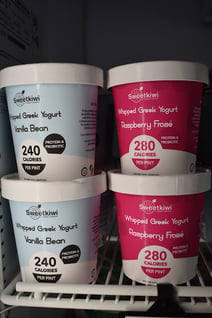Freezing Salt, Fat, and Sugar

It happens all the time. We buy a product we love, and it goes bad before we can even enjoy it. How can we stop this from occurring? The answer is simple: freezing our food before it goes bad. In this article, we will discuss the freezing process of foods containing salt, fat, and sugar.
Did you know humans have used freezing as a technique to preserve food for centuries? Although techniques have changed throughout the years, the concept of freezing food has been around since we have been able to hunt animals. It wasn’t until the 1990s that frozen food became a staple in the diets of many American families.
Freezing is one of the most effective ways to preserve food for long periods of time. When freezing occurs, the matter becomes a solid due to cooling. The energy of the molecules in an object decreases as it gets closer to the freezing point, which is 32 degrees Fahrenheit. Freezing food is a popular way of preservation because it limits the amount of available water for spoilage microorganisms, thus slowing the growth of microbes that cause food-borne illnesses and spoilage. The way frozen food is stored is one of the most crucial factors in ensuring that microbes are unable to grow and move.
While it depends on the type of food, frozen food generally has a shelf life of about 12 months before it goes bad. However, there are factors you can take into account to ensure that the shelf life lasts as long as possible. The primary factor to manage with frozen food is ensuring the food is at or below 40°F before placing it in the freezer. The warmer the food, the more likely it is to affect the temperature of the freezer and the items around it. When the freezer gets too warm, food will melt causing both structural damage (from the shrinking and expanding between water and ice) and creating an environment more conducive to microbial growth.
Another factor to control is storage. Once your food is at or below 40°F, , store it in an airtight container. This limits the amount of oxygen that comes in contact with the food, which prevents spoilage or freezer burn. Be sure to note, however, that foods with a high water content will expand when freezing. This means your freezing container should account for expansion in foods with high water content.
Although you can bank on frozen foods having a 12-month shelf life, , different variables in your product formulation react in the freezing process. Freezing foods that have a high salt content can cause the salt in the product to lose its taste. Additionally, salt can affect other factors in frozen food, such as the fat content. Salt causes the fat in foods to go rancid when undergoing the freezing process. Rancidification occurs when fat cells are broken down, which causes an unappealing smell and taste.
In addition to foods with a high salt content, foods that have a high fat content have unique reactions when undergoing the freezing process. Foods such as sauces can separate when frozen. Therefore, you should be mindful of how you store certain foods that have the ability to separate if you want to preserve the texture. Additionally, fatty foods tend to deteriorate quickly. This is because fat easily absorbs oxygen. However, freezing can slow down this process.
In contrast to high salt and high fat content foods being difficult to freeze, foods that have a high sugar content freeze and preserve with little-to-no issues. Sugar protects the texture of the food when frozen. The higher the sugar content, the lower the freezing point. This step prevents large ice crystals from forming that take away the smooth and creamy texture in frozen desserts like ice cream . Small ice crystals are the ideal size for sweet frozen treats.
While there are many factors to consider when freezing food, freezing is one of the oldest and most effective ways of preserving food. When done correctly, it increases the shelf life of many foods. Ingredients react differently when frozen. For example, high salt and fat foods are harder to freeze, while high sugar foods freeze well. If a customer buys a frozen product of a company that did not take into consideration how salt causes fat to release an odor and taste funny, they will not be satisfied and will likely not buy from that brand again. This is why understanding these elements is essential in making sure a product meets customer approval.

Comments